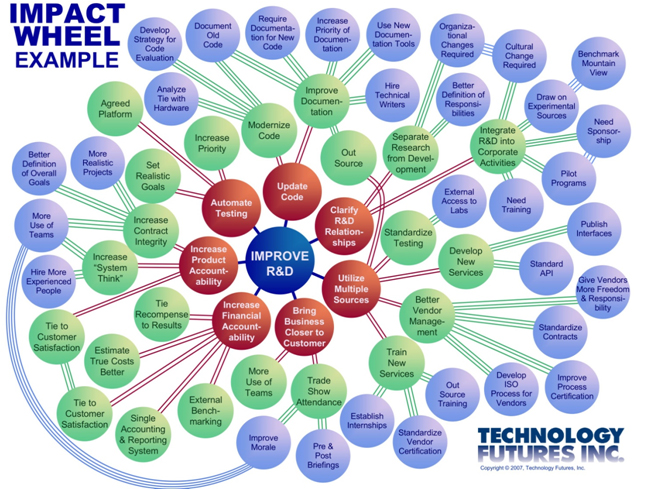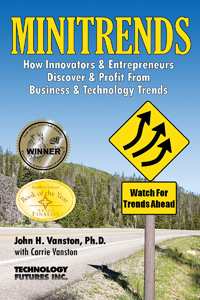Opportunity Wheels
MiniTrends Opportunity Wheels are an Excellent Tool for
MiniTrends Discovery, Analysis, and Exploitation
As stated in our book MINITRENDS: How Innovators & Entrepreneurs Discover & Profit From Business & Technology Trends, The MiniTrends Opportunity Wheel is an excellent multi-purpose MiniTrends discovery and exploitation tool. It can be applied in many situations where exploring for or discovering impacts and implications that are non-obvious is necessary. The opportunity wheel allows you to explore the realm of the possible and to increase your awareness of potential implications. Moreover, it is a multiple right-answer tool. Use it to explore the possible implications of a trend, innovation, goal, policy decision, or any decision that is about to be made.
Specifically, the opportunity wheel is a small group technique (one person is okay — four to six persons is preferable) which can successfully be used to ease participants out of thinking about a problem (situation/goal) in a linear, point-to-point, single vector fashion. Rather, the group is required to approach the problem statement in a central hub. Then, participants work off the hub in a concentric fashion, beginning with the first order and only going to the next order after all elements (or some other reasonable number, i.e., 6) have been defined. For constructing the wheel, simple steps are outlined below.
![]() 1. A statement is placed in a circle (hub) in the middle of a large sheet of paper. The assumption is made that the trend (or whatever) will continue.
1. A statement is placed in a circle (hub) in the middle of a large sheet of paper. The assumption is made that the trend (or whatever) will continue.
 2. The participants are asked to identify immediate, direct consequences of what is placed in the hub. These are first order impacts. The only restrictions are that the ideas generated are possible and first order in nature.
2. The participants are asked to identify immediate, direct consequences of what is placed in the hub. These are first order impacts. The only restrictions are that the ideas generated are possible and first order in nature.
 3. Next, second order impacts are generated off each first order circle. Each first order impact is considered individually, but not necessarily in order of original creation. Go for at least two new impacts, looking for both positive and negative possibilities. These are “impacts of impacts.”
3. Next, second order impacts are generated off each first order circle. Each first order impact is considered individually, but not necessarily in order of original creation. Go for at least two new impacts, looking for both positive and negative possibilities. These are “impacts of impacts.”
4. Continue this process through third and fourth orders of impact. Same or very similar impacts may appear more than once on the same level or different levels. It is okay to be humorous or even off-the-wall. Remember that this is exploratory.
5. Tie impacts together into opportunities wherever a natural, dynamic-feed situation seems to occur. This is done with a single line from one opportunity to another. You may cross-levels and you may give the line a directional flow indication if appropriate. 
 A single application of this technique will not uncover a complete set of possible opportunities. Having more than one group examine the same statement and then compare results is very useful. No two wheels will be exactly alike, even though there may be some overlap. Multiple wheels produced on the same topic increase the chances of discovering a larger range of possible opportunities.
A single application of this technique will not uncover a complete set of possible opportunities. Having more than one group examine the same statement and then compare results is very useful. No two wheels will be exactly alike, even though there may be some overlap. Multiple wheels produced on the same topic increase the chances of discovering a larger range of possible opportunities.

MiniTrends Opportunity Wheel – How to Find Emerging Opportunities
______
When conducting an opportunity analysis on the wheel, we suggest stepping back and taking a look at your handiwork. Assuming that there are two or more wheels to analyze (this also works for just one wheel) we suggest:
- Hang the wheels side by side for comparison. Systematically compare the results.
- Look for common impacts and trends
- Look for positive impacts
- Look for negative impacts
- Look for “show stoppers”
- Use color to make your designations and mark the various discoveries with colored pens. Make use of the dynamic ties¾what do they seem to indicate?
- How many common impacts and trends are evident? Does an overlap represent a significant finding, “common wisdom,” or both?
- How many really positive impacts are there?
- How many really negative impacts are there? Are you prepared to deal with their manifestations?
- The “show stoppers” by definition, must be dealt with.
HINTS
- The more this technique is used, the better the participants get at using it. To learn it even better, teach it to someone else.
- Use this technique to exhaust a topic or to do a “quick and dirty” study.
- Use this technique to involve, in a small group setting, many diverse thinking individuals. Cross communication is a huge benefit that is not obvious on paper.













